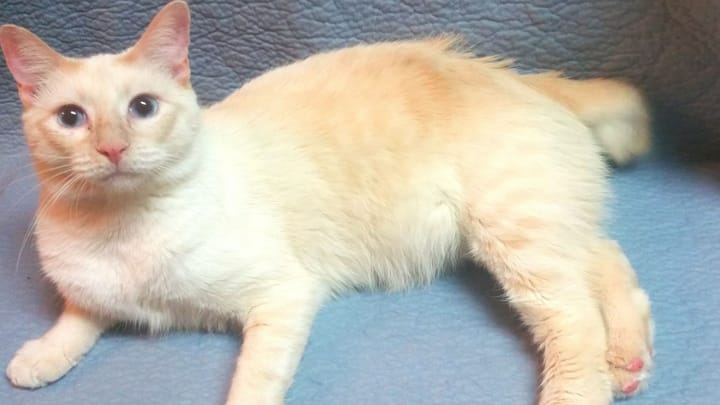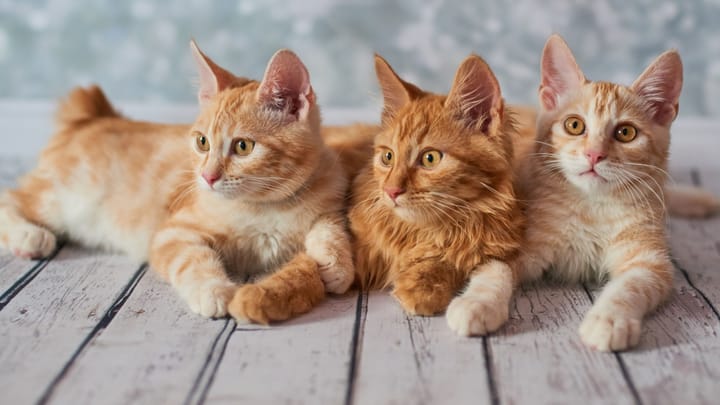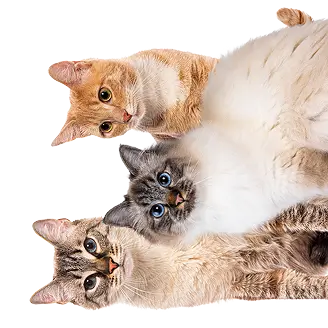American Bobtail


The American Bobtail is the result of a genetic mutation. The breed appeared spontaneously, with no human intervention. They are by no means a crossbreed, and have no relation to the Japanese Bobtail. Humans simply selected individuals with the same characteristically shorter tail, in order to define the features of the breed and grant it a pedigree. So while this Lynx-like cat may look like a wild feline, this is only in appearance: they are purely domestic cats at heart.
|
Life expectancy |
The American Bobtail has a life expectancy of between 15 and 18 years |
|
Temperament |
|
|
Adult size |
Female
Between 14 and 16 in
Male
Between 14 and 16 in
|
|
Adult weight |
Female
Between 11 and 18 lb
Male
Between 13 and 20 lb
|
|
Coat colour
Black / seal, blue / grey-slate, chocolate, lilac / lilac, cinnamon / cinnamon, fawn / fawn, red, white, tortoiseshell (no restrictions) |
Black Brown White Red Cream Blue |
|
Type of coat
Short or mid-length, with a good undercoat. |
Short Long |
|
Eye colour
Blue siamese blue, aquamarine, ice blue, white haloed, tonkinese aqua, green, hazel, golden yellow, lemon yellow, amber, copper, orange, blue eyed albino, lilac eyed albino, pink eyed albino, ojas azules, chinchilla turquoise, dichroic eyes (as long as the colour matches the coat, there are no restrictions) |
Blue
Green
Yellow
Brown
Odd-eyed
|
|
Purchase price |
The American Bobtail costs between £450 and £750 |
The tail of the American Bobtail varies in length and shape from one cat to another, since the gene responsible is impossible to control. It is also a dominant gene, but is different from the Manx gene, since they always have at least a small tail.
More details about the American Bobtail
American Bobtail: Origins and history
The American Bobtail is a very recent natural breed. Legend has it that the patriarch of the breed is a brown tabby kitten with a tiny tail that was wandering around a reserve in Arizona in the late sixties. A young American couple on holiday, the Sanders, fell under his spell. They named him Yodi and brought him home with them in Iowa. Yodi wooed the family's cat, a colour-pointed kitten without a pedigree, who then gave birth to a litter of short-tailed kittens. A friend of the Sanders was intrigued by these peculiar kittens and decided to turn them into an official breed. Domestic cats with the characteristic short tail were found throughout the United States and Canada, and their breeders simply helped nature along by breeding these cats together. Along the way, a long-haired cat was introduced into the lineage, which led to the appearance of a variant of the American Bobtail with mid-length hair.
The breed has been recognised by TICA since 1989.
Physical characteristics of the American Bobtail
The American Bobtail is a medium to large, semi-cobby cat. Their sturdy bone structure and well-developed musculature, along with their broad chest and slightly arched back (due to longer hind than front legs), give them the appearance of a small Lynx. Their head is broad with prominent cheeks and a strong chin, and a triangular-shaped muzzle a little wider than it is long. Their eyes are big and slightly almond-shaped. Their ears, which are average sized and sit quite low on the skull, each have a small tuft of fur at the end known as “Lynx tips”. The variety with mid-length fur also have tufts of fur between the toes.
But the main feature of this cat is of course their tail! Never absent, but always short, the maximum length is generally towards the tip of the tarsus (the hock). It is covered with fairly long, thick and shaggy fur. It is also extremely expressive, and will hide nothing about the emotional state of its owner.
American Bobtail: Characteristics
American Bobtail: Behaviour
Breed compatibility American Bobtail
American Bobtail: Purchase price
The average purchase price varies between £450 and £750. Lineage, age, sex, color, etc. are all factors that can change the price. For the monthly budget, the required spend will be around £25 to £35 per month.
American Bobtail: Shedding
Light
For both short-haired and long-haired varieties, hair loss is not very heavy, except perhaps during moulting periods.
American Bobtail: Grooming
Not very demanding, but they will need a gentle brush once a week, perhaps a little more during seasonal moults.
American Bobtail: Health
They live on average 15 years or more.
A true North American cat, they are robust and resistant.
Being a little on the lazy side, they can be more prone to chubbiness.
Reputed for their iron constitution, American Bobtails are rarely sick. They are not, however, immune to the health problems found in all cats. They have a certain vulnerability to periodontal disease (gingivitis and tartar), so preventative measures and dental care are recommended. There are also certain illnesses associated with this particular breed:
- Hip dysplasia, which causes a lameness of one or more hind legs.
- There is also a slightly higher risk of spine problems due to the genetic mutation that shortened the tail.
There are no unique characteristics about the reproduction of this breed.




